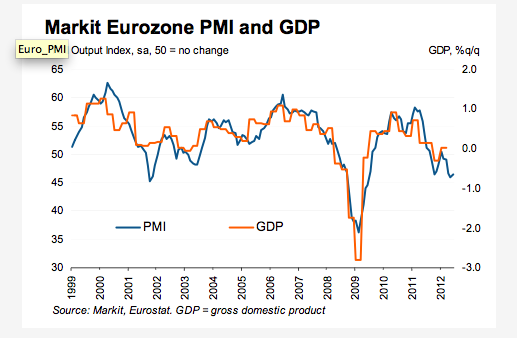Thursday, July 5, 2012
Europe’s Crisis is Re-Emerging
By Delusional Economics, who is horrified at the state of economic commentary in Australia and is determined to cleanse the daily flow of vested interests propaganda to produce a balanced counterpoint. Cross posted from MacroBusiness.
As I‘ve been saying over the last few days, last week’s EU summit providedEurope
with some political success but actual deliverables are some time off. According to the Finnish PM at least a year. There is already rumbling from a number of countries, including Germany, about what exactly was and wasn’t decided last Friday morning and my suspicious are, as we’ve seen many times before, that final outcomes will be some 17, or 27, headed beast built on layers of political compromise.
In the meantime the implementation of austerity policy across the periphery, and now France it seems, continues to lead to a slowing economy across the monetary union.
Overnight we had yet another tranche of PMI data that once again highlighted the same downward trend.

Detailed reports of individual country’s June service’s PMI were also released with much the same story. Germany‘s service sector stagnated while its business outlook deteriorated markedly. French services activity remained in contraction, declining at slower pace, but business expectations fell to 39-month low. Italy saw further marked decreases in services activity while job shedding accelerated. Spain saw a sharp reduction in business activity, and finally, Ireland‘s service sector activity continued to fall although at nothing like the pace of the southern economies.
So its a very grim picture across the board as this collection of charts shows.

Last December I wrote a follow-up piece on the risks in the French economy in which I stated:
With peripheral yields rising once again one wonders what Europe can come up with next. Maybe the ECB will have some surprises in todays’ monetary policy decisions. It had better.
As I‘ve been saying over the last few days, last week’s EU summit provided

In the meantime the implementation of austerity policy across the periphery, and now France it seems, continues to lead to a slowing economy across the monetary union.
Overnight we had yet another tranche of PMI data that once again highlighted the same downward trend.
EuroZone composite PMI – June 2012 Final
Eurozone PMI rises in June but still signals steep rate of contraction
Final Eurozone Composite Output Index: 46.4 (Flash 46.0, May 46.0)The Eurozone economic
Final Eurozone Services Business Activity Index: 47.1 (Flash 46.8, May 46.7)
Near-record fall in service sector confidencedownturn extended into a fifth consecutive month in June, as the debt and political crises continued to have an adverse impact on both the manufacturing and service sectors.
At 46.4 in June, the Markit Eurozone PMI Composite Output Index was higher than both May’s reading of 46.0 and the earlier flash estimate of 46.0, but still remained deep in contraction territory. The average reading for Q2 2012 was the lowest for three years as a result.
Rates of decline eased marginally in both services and manufacturing, but both sectors have seen the strongest quarterly contractions for three years in the second quarter.
The spreading of the economic malaise from the periphery of the currency union to its core continued in June. German output contracted at the fastest rate in three years, and France also saw a further decline (albeit slower than in May). Italy and Spain, meanwhile, remained in deep recessions.

Detailed reports of individual country’s June service’s PMI were also released with much the same story. Germany‘s service sector stagnated while its business outlook deteriorated markedly. French services activity remained in contraction, declining at slower pace, but business expectations fell to 39-month low. Italy saw further marked decreases in services activity while job shedding accelerated. Spain saw a sharp reduction in business activity, and finally, Ireland‘s service sector activity continued to fall although at nothing like the pace of the southern economies.
So its a very grim picture across the board as this collection of charts shows.

Last December I wrote a follow-up piece on the risks in the French economy in which I stated:
.. France would be next after Italy in the contagion breakdown because of its macroeconomic metrics. High levels of public and private debt, a long running negative trade balance and current account deficit, stalling industrial production, GDP and employment along with significant banking sector exposure to the periphery all add up to a fairly risky predicament. This is certainly not a country that could take on a strict austerity regime without causing itself some significant short-to-medium term economic damage because it is obvious from the metrics that the private sector has been borrowing from both the external and government sectors for a long period of time.It appears from the data that Italy is now well within the embrace of the crisis and that France is heading in the same direction. Given France’s main trading partners are Germany, Italy and Spain it is very unlikely that a campaign of government austerity is going to reverse that trend, in fact all things being equal, I would expect acceleration.
With peripheral yields rising once again one wonders what Europe can come up with next. Maybe the ECB will have some surprises in todays’ monetary policy decisions. It had better.



